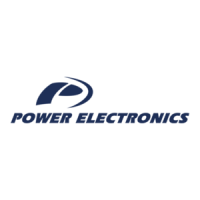How to fix I/O board or external communication board fault on Power Electronics SD300 Inverter?
- IismithSep 12, 2025
Check the board is properly connected and it is not damaged.

How to fix I/O board or external communication board fault on Power Electronics SD300 Inverter?
Check the board is properly connected and it is not damaged.
What does BX error mean on Power Electronics SD300?
The Power Electronics Inverter is being forced to cut the output supply and stop due to inertia.
What does Pipe Fill Flt mean on a Power Electronics SD300?
An error has been detected on the Power Electronics Inverter, which makes the PID feedback always be under the established value. This could indicate a possible pipe breakdown.
What does Slot 1 Fail mean on a Power Electronics SD300 Inverter?
The optional board located in slot 1 of the Power Electronics Inverter has been extracted, or there is no possible communication.
What does Param_Wr_Err mean on Power Electronics Inverter?
A problem has been detected during the writing of a parameter by keypad on the Power Electronics Inverter.
Why does my Power Electronics SD300 show an overvoltage error?
The Power Electronics Inverter trips if the DC voltage within the bus exceeds the established value. This can occur during deceleration, when the motor's regenerative energy return to the drive is excessive for the capacitors in the DC bus, or due to a temporary overvoltage in the supply system.
What does STO error mean on a Power Electronics SD300?
Automatic internal protection of several of the IGBT semiconductors has activated, or the safe stop contact of the Power Electronics Inverter (connected to an external circuit by the user) has been activated (for example, an emergency stop).
What does Lost command mean on Power Electronics SD300 Inverter?
The Power Electronics Inverter trips due to a loss of speed set point established by the use of the control or communication terminals.
What does External Trip mean on a Power Electronics SD300 Inverter?
This function is used when the user needs to cut the output using an external trip signal. The open/closed contact use depends on the configuration within the digital inputs (In.65-In.71) configured as 4 'EXTERNAL TRIP'. The Power Electronics Inverter cuts the motor output, protecting it from the controlled situation within the terminal.
Why does my Power Electronics SD300 Inverter show a No Motor error?
The Power Electronics Inverter has not detected a connected motor at its output when the start order was given. This protection is enabled when parameter Pr.31 is set to a value other than 0 ('NONE').
| Brand | Power Electronics |
|---|---|
| Model | SD300 Series |
| Category | Inverter |
| Language | English |
Explains how to mount the SD300 drives on a wall or inside a panel, emphasizing fire resistance and clearance.
Provides installation recommendations for power connection and wiring, including safety checks for DC link discharge.
Explains the procedure for properly grounding the drive chassis and motor to ensure safety and prevent interference.
Advises on parallel cable routing, distance maximization, and using shielded cables for data and control signals.
Provides terminal schema for IP20 drives, detailing digital inputs, outputs, and analog connections.
Defines the STO function, its safety levels (SIL2, SIL1), and its application in maintenance without power disconnection.
Warns that only qualified personnel should commission the drive, following safety instructions and regulations.
Lists possible fault messages, screen codes, and descriptions, with probable causes and troubleshooting actions.
Describes parameters for basic setup of the drive via the integrated display, including target frequency and acceleration/deceleration times.
Details parameters related to drive functions such as local speed, local torque, acceleration ramp, and deceleration ramp.
Covers parameters for basic functions like auxiliary speed reference, calculation type, and auxiliary reference gain.
Explains parameters for expanded functions such as acceleration/deceleration patterns, motor start modes, and stop modes.
Details parameters for Modbus communication, including slave address, protocol selection, baud rate, and frame structure.
Lists various protection parameters such as overload, underload, phase loss, and motor fault protections.
Covers parameter configurations for controlling PM synchronous motors, including basic and internal motor parameters.